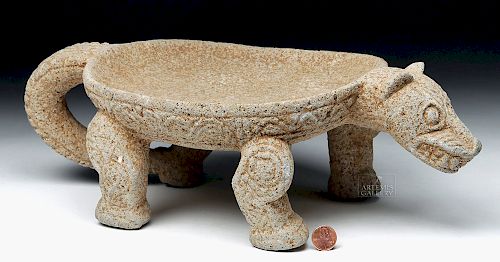Panamanian Chiriqui Stone Metate - Jaguar Form
Lot 31
About Seller
Artemis Gallery
686 S Taylor Ave, Ste 106
Louisville, CO 80027
United States
Selling antiquities, ancient and ethnographic art online since 1993, Artemis Gallery specializes in Classical Antiquities (Egyptian, Greek, Roman, Near Eastern), Asian, Pre-Columbian, African / Tribal / Oceanographic art. Our extensive inventory includes pottery, stone, metal, wood, glass and textil...Read more
Estimate:
$8,000 - $10,000
Absentee vs Live bid
Two ways to bid:
- Leave a max absentee bid and the platform will bid on your behalf up to your maximum bid during the live auction.
- Bid live during the auction and your bids will be submitted real-time to the auctioneer.
Bid Increments
| Price | Bid Increment |
|---|---|
| $0 | $25 |
| $300 | $50 |
| $1,000 | $100 |
| $2,000 | $250 |
| $5,000 | $500 |
| $10,000 | $1,000 |
| $20,000 | $2,500 |
| $50,000 | $5,000 |
| $100,000 | $10,000 |
| $200,000 | $20,000 |
About Auction
By Artemis Gallery
May 10, 2018
Set Reminder
2018-05-10 10:00:00
2018-05-10 10:00:00
America/New_York
Bidsquare
Bidsquare : Fine Ethnographic / Asian / Ancient Art
https://www.bidsquare.com/auctions/artemis-gallery/fine-ethnographic-asian-ancient-art-3213
Featuring antiquities from around the world including Pre-Columbian, Tribal, Classical, Asian, so much more! Artemis Gallery info@artemisgallery.com
Featuring antiquities from around the world including Pre-Columbian, Tribal, Classical, Asian, so much more! Artemis Gallery info@artemisgallery.com
- Lot Description
Pre-Columbian, Costa Rica, Atlantic Watershed, ca. 800 to 1200 CE. A jaguar metate, hand-carved from a single piece of volcanic stone. The metate has a broad back, slightly concave, forming a grinding surface. It stands on four legs with paw-like feet. At one end is a jaguar's head, its rounded ears perked, its eyes and mouth emphasized. Most impressive are the elegant proportions of the piece and the extensive detailing of the facial features and furry coat which is covered with abstract geometric motifs. Furthermore, the sculptor of this piece skillfully delineated an expressive countenance on the wild feline; just look at those bulging eyes, gnashing fangs, alert ears, and snarling snout as he stands proudly on his four legs and his curled tail bristles with energy. Size: 15.5" L x 8" W x 5.125" H (39.4 cm x 20.3 cm x 13 cm)
Metate technology developed initially for the utilitarian purpose of grinding corn; however, the objects evolved into meaningful ritual objects, replete with strong iconography and intriguing sculptural forms. Examples of a larger scale but similar degree of decorative carving and iconographic symbolism were sometimes used to seat a departed lord on his journey to the afterlife. Jaguar imagery symbolized power and might throughout the Pre-Columbian world; hence, warriors, rulers, hunters, and shamans alike associated themselves with this king of beasts, the largest and most powerful feline in the New World.
Provenance: ex-private collection of Mary K. F. Leong, Washington, USA, 1980-1990
All items legal to buy/sell under U.S. Statute covering cultural patrimony Code 2600, CHAPTER 14, and are guaranteed to be as described or your money back.
A Certificate of Authenticity will accompany all winning bids.
We ship worldwide and handle all shipping in-house for your convenience.
#131976Normal surface wear commensurate with age. Areas of mineral and mineral deposits.Condition
- Shipping Info
-
All shipping is handled in-house for your convenience. Your invoice from Artemis Gallery will include shipping calculation instructions. If in doubt, please inquire BEFORE bidding for estimated shipping costs for individual items.
-
- Buyer's Premium



 EUR
EUR CAD
CAD AUD
AUD GBP
GBP MXN
MXN HKD
HKD CNY
CNY MYR
MYR SEK
SEK SGD
SGD CHF
CHF THB
THB
















